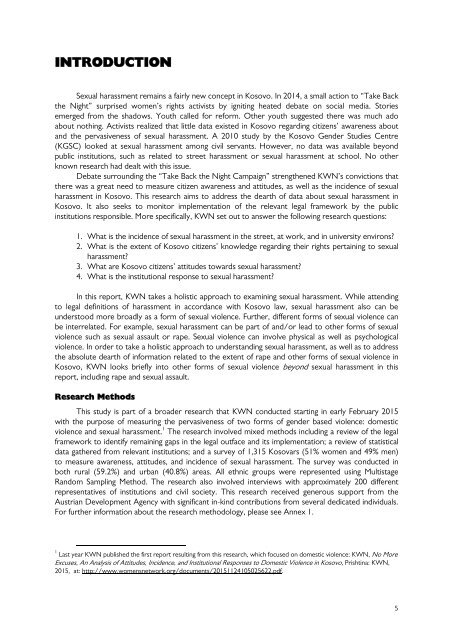Sexual Harassment in Kosovo
20160223185243349
20160223185243349
You also want an ePaper? Increase the reach of your titles
YUMPU automatically turns print PDFs into web optimized ePapers that Google loves.
INTRODUCTION<br />
<strong>Sexual</strong> harassment rema<strong>in</strong>s a fairly new concept <strong>in</strong> <strong>Kosovo</strong>. In 2014, a small action to “Take Back<br />
the Night” surprised women’s rights activists by ignit<strong>in</strong>g heated debate on social media. Stories<br />
emerged from the shadows. Youth called for reform. Other youth suggested there was much ado<br />
about noth<strong>in</strong>g. Activists realized that little data existed <strong>in</strong> <strong>Kosovo</strong> regard<strong>in</strong>g citizens’ awareness about<br />
and the pervasiveness of sexual harassment. A 2010 study by the <strong>Kosovo</strong> Gender Studies Centre<br />
(KGSC) looked at sexual harassment among civil servants. However, no data was available beyond<br />
public <strong>in</strong>stitutions, such as related to street harassment or sexual harassment at school. No other<br />
known research had dealt with this issue.<br />
Debate surround<strong>in</strong>g the “Take Back the Night Campaign” strengthened KWN’s convictions that<br />
there was a great need to measure citizen awareness and attitudes, as well as the <strong>in</strong>cidence of sexual<br />
harassment <strong>in</strong> <strong>Kosovo</strong>. This research aims to address the dearth of data about sexual harassment <strong>in</strong><br />
<strong>Kosovo</strong>. It also seeks to monitor implementation of the relevant legal framework by the public<br />
<strong>in</strong>stitutions responsible. More specifically, KWN set out to answer the follow<strong>in</strong>g research questions:<br />
1. What is the <strong>in</strong>cidence of sexual harassment <strong>in</strong> the street, at work, and <strong>in</strong> university environs?<br />
2. What is the extent of <strong>Kosovo</strong> citizens’ knowledge regard<strong>in</strong>g their rights perta<strong>in</strong><strong>in</strong>g to sexual<br />
harassment?<br />
3. What are <strong>Kosovo</strong> citizens’ attitudes towards sexual harassment?<br />
4. What is the <strong>in</strong>stitutional response to sexual harassment?<br />
In this report, KWN takes a holistic approach to exam<strong>in</strong><strong>in</strong>g sexual harassment. While attend<strong>in</strong>g<br />
to legal def<strong>in</strong>itions of harassment <strong>in</strong> accordance with <strong>Kosovo</strong> law, sexual harassment also can be<br />
understood more broadly as a form of sexual violence. Further, different forms of sexual violence can<br />
be <strong>in</strong>terrelated. For example, sexual harassment can be part of and/or lead to other forms of sexual<br />
violence such as sexual assault or rape. <strong>Sexual</strong> violence can <strong>in</strong>volve physical as well as psychological<br />
violence. In order to take a holistic approach to understand<strong>in</strong>g sexual harassment, as well as to address<br />
the absolute dearth of <strong>in</strong>formation related to the extent of rape and other forms of sexual violence <strong>in</strong><br />
<strong>Kosovo</strong>, KWN looks briefly <strong>in</strong>to other forms of sexual violence beyond sexual harassment <strong>in</strong> this<br />
report, <strong>in</strong>clud<strong>in</strong>g rape and sexual assault.<br />
Research Methods<br />
This study is part of a broader research that KWN conducted start<strong>in</strong>g <strong>in</strong> early February 2015<br />
with the purpose of measur<strong>in</strong>g the pervasiveness of two forms of gender based violence: domestic<br />
violence and sexual harassment. 1 The research <strong>in</strong>volved mixed methods <strong>in</strong>clud<strong>in</strong>g a review of the legal<br />
framework to identify rema<strong>in</strong><strong>in</strong>g gaps <strong>in</strong> the legal outface and its implementation; a review of statistical<br />
data gathered from relevant <strong>in</strong>stitutions; and a survey of 1,315 Kosovars (51% women and 49% men)<br />
to measure awareness, attitudes, and <strong>in</strong>cidence of sexual harassment. The survey was conducted <strong>in</strong><br />
both rural (59.2%) and urban (40.8%) areas . All ethnic groups were represented us<strong>in</strong>g Multistage<br />
Random Sampl<strong>in</strong>g Method. The research also <strong>in</strong>volved <strong>in</strong>terviews with approximately 200 different<br />
representatives of <strong>in</strong>stitutions and civil society. This research received generous support from the<br />
Austrian Development Agency with significant <strong>in</strong>-k<strong>in</strong>d contributions from several dedicated <strong>in</strong>dividuals.<br />
For further <strong>in</strong>formation about the research methodology, please see Annex 1.<br />
1 Last year KWN published the first report result<strong>in</strong>g from this research, which focused on domestic violence: KWN, No More<br />
Excuses, An Analysis of Attitudes, Incidence, and Institutional Responses to Domestic Violence <strong>in</strong> <strong>Kosovo</strong>, Prisht<strong>in</strong>a: KWN,<br />
2015, at: http://www.womensnetwork.org/documents/20151124105025622.pdf.<br />
5


